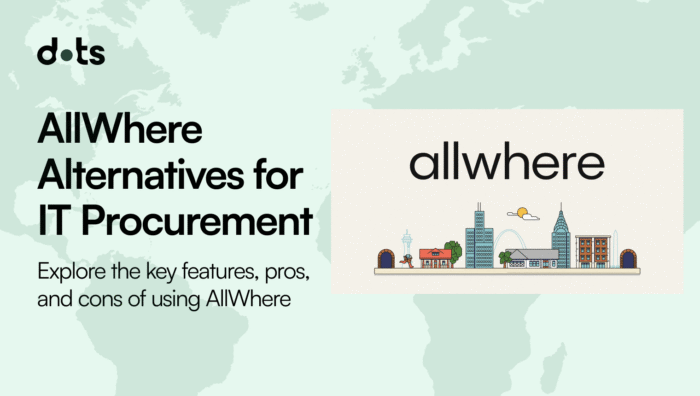Still remember the days when procurement meant chasing people for signatures? Or, worse, waiting for someone in leadership to approve your order for a device? People who’ve done IT procurement for a long time surely do.
But those days are over.
That’s because companies now use automation and artificial intelligence (AI) in their procurement processes. It does many of the tedious tasks that used to burn out human resources and IT teams. Researchers at the Wharton School of the University of Pennsylvania found that the use of generative AI once a week in procurement and purchasing increased by 44% between 2023 and 2024.
But there’s a twist, says Procurement Magazine. While the majority of leaders in the procurement industry believe in AI’s potential, 61% of teams still haven’t incorporated AI into their processes.
If you’re part of that 61%, we’ve prepared this article just for you.
AI’s Role in the New IT Procurement Playbook
Let’s start with a very important concept: massive data sets. Modern AI-powered IT procurement solutions can process them at lightning speed, comparing suppliers and forecasting spending in seconds.
Even better, AI has simplified IT hardware procurement. What used to be an inconvenience for stakeholders is now as easy as clicking a button. The tool can find the best price, delivery speed, and the right devices for your needs. And the best part? AI can even help companies deploy assets to employees worldwide.
Image suggestion: Illustration of an overwhelmed procurement manager getting “relieved” by an AI assistant — humorous but professional tone (showing AI taking on repetitive tasks).
Here are even more practical applications of AI in IT procurement:
Automation from equipment provisioning and returns
Equipment provisioning and returns were previously the IT hardware procurement scavenger hunt that included tons of emails and requests. Nowadays, AI-powered solutions have automatic triggers for purchase orders, with the right specs and delivery arrangements ready. Then, procurement teams can monitor the device until it arrives and is in use.
What happens when an employee leaves? No problem. Tools can even arrange pickup and prepare the items for return or recycling.
That’s right. AI, with you at the control panel, can handle the entire asset lifecycle, like an all-in-one IT procurement services platform.
Multi-vendor sourcing, but speedy
Say goodbye to competitive bidding. AI simplifies the process by analyzing global data and historical info from your transactions with suppliers. All you have to do now, as the approver, is to choose among the recommendations provided by your IT procurement tool.
Analytics for budgets and spending
Predictive analytics review past purchase data, market pricing trends, and economic indicators to forecast spend. Procurement leaders can then identify cost-saving opportunities before budgets are locked.
Contract alerts and automation
Contract lifecycle management has been redefined. Intelligent systems extract key clauses, flag renewals, and suggest opportunities for consolidation. The result: fewer missed deadlines and more informed negotiations.
Supplier health monitoring
Algorithms can analyze everything from on-time delivery rates to geopolitical developments. By surfacing early warnings, procurement teams can prevent supply disruptions and diversify vendors where necessary.
And here are the potential business outcomes:
- Faster onboarding and offboarding cycles
- Reduced equipment losses through accurate asset tracking
- Lower procurement costs from competitive multi-vendor sourcing
- Greater transparency across procurement services
Evidence Procurement Leaders Care About: Measurable Outcomes and Statistics
Executives don’t want buzzwords—they want results. And AI is already producing them. Boston Consulting Group’s findings will give procurement leaders plenty to smile about:
- Around 90% of manual spend analysis can be eliminated with AI-based tools.
- Supplier communication tasks see time savings of roughly 85%.
- Companies can uncover a 15% savings potential when using AI to select the right tools and suppliers.
On the ground, these numbers translate into concrete wins, including faster supplier negotiations, more accurate budgeting, and fewer late surprises in procurement cycles.
A Practical Rollout Plan for Procurement Leaders
Procurement leaders don’t need to flip the switch overnight. Instead, they can take measured steps to integrate AI into workflows:
- Audit workflows: Pinpoint the repetitive, error-prone processes, for example, manual contract renewals or spreadsheet-based asset tracking.
- Pilot specific use cases: Start small, such as automating vendor scoring or spend forecasting, and expand once results are clear.
- Upskill teams: Provide training that moves procurement professionals into higher-value roles like supplier strategy and category management.
- Select integrated platforms: Ensure chosen systems work seamlessly with HRIS, MDM, finance, and security solutions to avoid creating new silos.
Common Barriers and Practical Ways to Reduce Risk
No technology rollout is without challenges, and AI in procurement is no exception. Below are some things to watch out for and some practical tips for solving them:
- Data quality: Poor or incomplete supplier and spend data limits AI accuracy. The fix is to invest in better data management practices before scaling.
- Staff resistance: Procurement professionals may worry that automation will reduce their role. Leaders should emphasize using AI to reduce busywork, allowing staff to focus on higher-value tasks.
- Cost justification: Executives often need hard ROI numbers. Small pilots and clear KPIs provide the evidence needed to justify investment.
- Vendor lock-in: Overdependence on a single platform can be risky. Choosing systems that support integrations and data portability helps avoid long-term issues.
Looking Ahead: Procurement as a Strategic Business Driver
IT procurement used to be judged on savings alone. In 2025, AI is reshaping it into a function that enables growth, agility, and resilience. With AI at the center, leaders can show stakeholders exactly how decisions are made, building trust through greater transparency.
For organizations ready to cut out the busywork and bring transparency to global IT logistics, Dots is worth exploring. Our platform automates asset lifecycles, multi-vendor bidding, and integrations with HRIS and MDM, with all-in-one procurement solutions helping teams deliver faster, smarter results.




